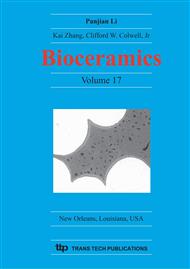p.365
p.369
p.373
p.377
p.381
p.387
p.391
p.395
p.399
Improvement of Bioactivity of Hydroxyapatite Ceramics by Adding Glass
Abstract:
In this study, we examined in vivo performance of newly developed hydroxyapatite (HA)ceramics, which is obtained by sintering the HA powder mixed with CaO·MgO·SiO2-based glass at 1000°C (liquid phase sintering). Bioactivity of this glass-containing HA was evaluated compared with the control HA by mechanical test and histological examination. The glass-containing HA showed higher bone-bonding strength than the control HA throughout the experimental period. Light microscope and backscattered scanning electron microscope (SEM) showed that the both kinds of implants bonded directly to the bone. High bioactivity in vivo, especially in the early period after implantation, of this newly developed HA was confirmed, which is one of the essential requirement for optimal bone substitutes.
Info:
Periodical:
Pages:
381-386
Citation:
Online since:
April 2005
Price:
Сopyright:
© 2005 Trans Tech Publications Ltd. All Rights Reserved
Share:
Citation:


